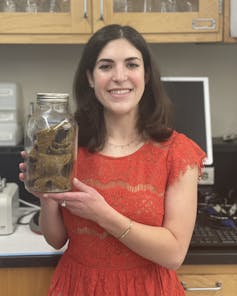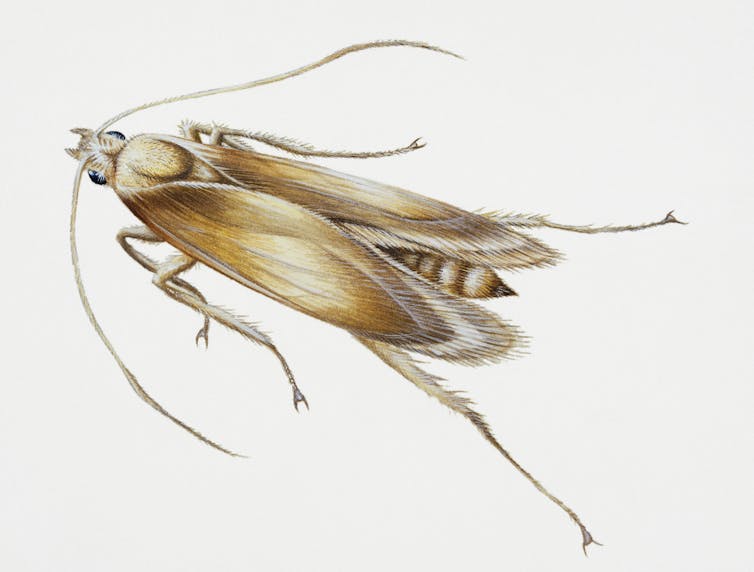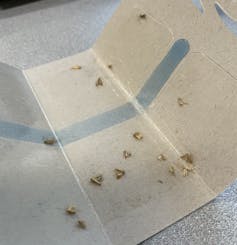by Isabel Novick, Boston University
Every day, I come into the lab to check the moth jar. The jar, which previously housed a liter of honey, now contains a multitude of small golden moths and their wriggly caterpillar offspring.

Isabel Novick, CC BY-ND
The founding population came from within my house – pests that fervently fed on my sweaters, rugs and horsehair plaster. When they emerge from my walls in the evenings, I chase them with zeal and catch them in jam jars. “Moth!” I shout, jumping up from the couch, knocking over whatever is in front of me. In the lab, I feed them clippings of a mohair sweater that shrank in the wash, which I soak in brewer’s yeast.
I’m a doctoral candidate studying the evolutionary relationships within the moth family Tineidae. I’m interested in how webbing clothes moths, Tineola bisselliella, have dispersed so widely and colonized our homes so readily. I am using a population genetics approach, examining the DNA of isolated populations of moths from all over the world. They eat crazy stuff. They live mostly indoors. How did this happen?
Resourceful, vigorous, tanklike eating machines
Webbing clothes moths are part of a distinctive, primordial lineage called the fungus moth family. These guys emerged long before more well-known species like silk moths. If you’re unlucky, you are already aware of the destruction they can wreak on sweaters, rugs and upholstery. But you many not realize how fascinating Tineidae are.

These moths can eat hair, skin and feathers, all of which comprise a protein called keratin. Keratin – the main ingredient in nails, hoofs and horns – is notoriously tough to digest. Biologists still aren’t sure how clothes moths can metabolize keratin, and this is something I aim to address in my research. One study posits that they harbor a microorganism in their gut that uses digestive enzymes to break down keratin for them.
However mysterious the process may be, their nutritional needs can be met with as little as a hairball and some vitamin B, which they can glean from sweat, pee and food stains. Not only that, but research suggests these moths somehow produce water as a byproduct of digesting keratin, so they can happily survive within the dry recesses of your home.
Incredibly, webbing clothes moths can safely digest poisonous heavy metals like arsenic, mercury and lead. They can easily chew through soft plastics and metabolize synthetic fabrics. They have been known to feast on mummified human remains and have even been a recognizable pest long enough to be mentioned in the Bible. They are so economically destructive that by the 1990s they were causing up to US$1 billion in damage per year in the U.S. alone.
This pest insect, over time, has hitchhiked all over the world. It can now be found from Australia to Chile, from Nigeria to Canada. The current hypothesis is that these moths originated in Africa and expanded their range by hitchhiking on 19th-century ships.
Scientists consider webbing clothes moths synanthropes: organisms that benefit from, and have adapted to, human spaces, much like pigeons or bedbugs. They have taken this to an extreme and are now mostly found indoors.

Steve Roberts/De Agostini Picture Library via Getty Images
Researchers are still not sure what evolutionary adaptations have allowed these moths to colonize, and ultimately depend upon, human environments. However, it seems likely to me that their global domination is associated with their diet. Webbing clothes moths are known as facultative keratinophages, which means they can choose to eat and digest keratin, but it’s not a required part of their diet. This kind of nutritional flexibility is common to other well-known synanthropic species – is there anything a raccoon won’t eat? – and may be fundamental to the moths’ successful global dispersal.
Moth genes from around the world
To study the differences between populations of webbing clothes moths around the world, I am analyzing a type of genomic data made from sequencing “ultraconserved elements.” This technique targets specific genes that all moth species share, called orthologs, and compares the variable genetic regions on both sides of the conserved sequence. This data tells researchers like me how distantly related the clothes moths in, say, Australia are to clothes moths in Hawaii.

Isabel Novick, CC BY-NY
People generally want to help because they hope my research will yield better methods of moth eradication. Ultimately, it may, but I’m primarily interested in appreciating these organisms from an evolutionary perspective.
So far, I have received over 600 moths. But many of my correspondents don’t catch anything, or catch the wrong thing. Sometimes the trap gets thrown out with the trash. Sometimes I send a trap and never hear from the recipient again. It can be a frustrating process. I end up spending hundreds of dollars and sifting through hundreds of moths, most of them other tineids or pantry moths, looking for the flash of dusty golden wings.
I spend a lot of my time in the lab extracting moth DNA and a lot of time on my computer analyzing it. Ideally, this research will yield a more comprehensive picture of how moths in this family are related to one another, and clarify whether clothes moths from around the world are actually the species we think they are. If these moths are experiencing sexual isolation, we might be using the wrong methods to control them depending on their location.

Appreciation for a pest
Even though clothes moths can destroy your wardrobe or devour priceless objects like taxidermy, oriental carpets and upholstered furniture in museum collections, I can’t help but admire them.
They are not intentionally pests; they are innovative, cunning and endlessly capable. Their ability to capitalize on unfilled niches has allowed them to spread far and wide throughout homes everywhere. They’re not chomping through your drapes with malicious intent; they’re operating exactly as they evolved to, in a way that has worked to their advantage for thousands of years. The reasons people dislike them – being persistent, destructive and difficult to eradicate, not to mention dull-colored – are the reasons they’ve been able to survive and thrive so successfully for so long.
I gently urge you to consider their efficiency and determination as a sort of evolutionary elegance. How incredible is it for something to have evolved to eat the inedible, to occupy the uninhabitable and to overcome every evolutionary obstacle in its way? Of course, that doesn’t mean their damage can’t be devastating, or that battling these moths doesn’t stink. But, from an evolutionary standpoint, the webbing clothes moth should inspire wonder instead of disgust, awe instead of frustration, and instead of exasperation, admiration.
Isabel Novick, Doctoral Candidate in Ecology, Behavior and Evolution, Boston University
This article is republished from The Conversation under a Creative Commons license. Read the original article.